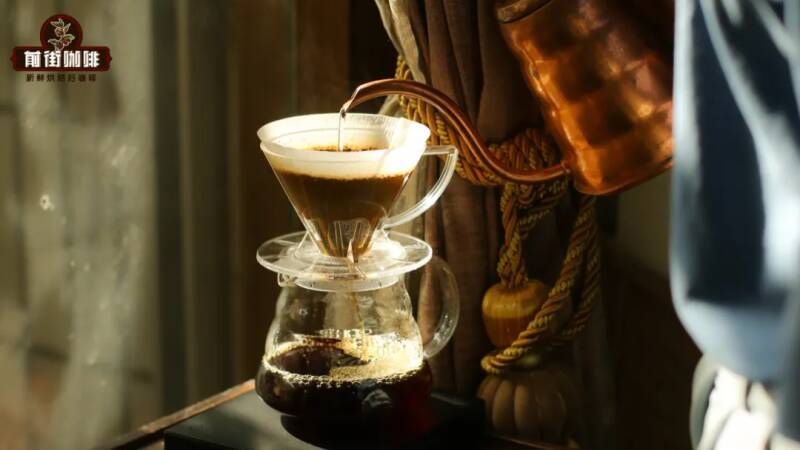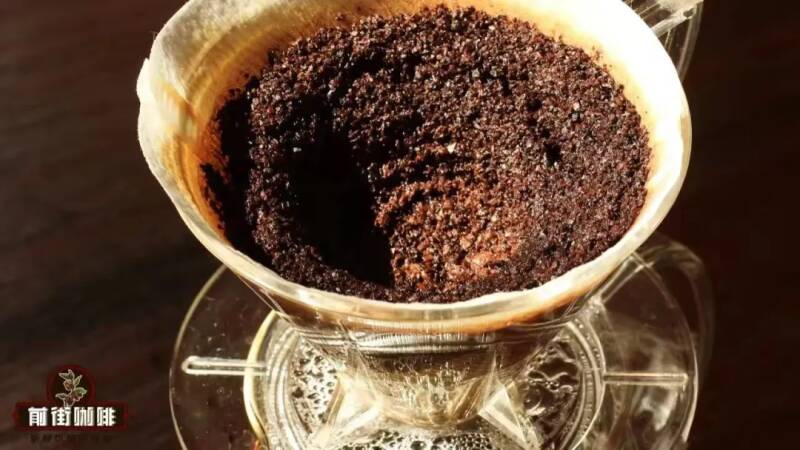The hand-brewed coffee powder pit is in perfect shape! Can you see the level of brewing from the coffee powder pit? How long does the hand-brewed coffee steam and simmer?
Yesterday, a friend talked about a very interesting phenomenon in the street. He found that most people still choose to stare at the changes in the filter cup while making coffee, even during the waiting interval when there is no need to inject water. It's like trying to pry out information from a powder bed.
Don't say, there is indeed some information that can be peeped out of the filter cup, and the amount is not small. For example, the freshness, density, grinding degree of coffee beans, the path and method of water injection, etc. These can all be read during the brewing process! So what Qianjie wants to share today is what kind of information we can read from during the process of making coffee.
1. The degree of bulging during steaming of the powder bed Steaming is a preparatory step that most brewing methods will be equipped with, because steaming can expel a large amount of carbon dioxide from the coffee powder, allowing the subsequently injected hot water to better dissolve the flavor substances. During the steaming process, the emitted carbon dioxide will form bubbles because it is wrapped in water, and then these bubbles will push the coffee powder bed upward, forming a hill-like bulge.
The bulging size of the powder bed and the degree to which it locks water can help us judge the freshness of the coffee, because the state of both depends mainly on the carbon dioxide content. When the carbon dioxide content is more, the bigger the bulge of the powder bed will be, and vice versa; then, because bubbles will form obstacles to slow down the water flow, when the carbon dioxide content is more, the water-locking effect will be stronger, and the powder bed can remain moist for a long time. On the contrary, when the carbon dioxide content is insufficient, the powder bed will quickly dry up. So we can see the freshness of this coffee bean from the size of the bulge and the degree of water-locking during steaming, because when the coffee bean is fresher, the more complete the carbon dioxide stored during roasting will be retained, and the bulge during steaming will naturally be relatively larger, and the water-locking effect will be better.
Deep-roasted coffee tends to bulge larger packets than lightly roasted coffee, because the carbon dioxide content is also linked to the degree of roasting. The deeper the roast is, the more carbon dioxide will accumulate in the coffee beans. At the same time, the greater the expansion rate of beans, the larger the bulging bag will naturally be.
2. Raise the height of the powder bed. The powder bed is a water injection technique that we often use when making coffee! This technique specifically refers to increasing the flow rate of water injection so that the water injection rate is higher than the drainage rate to raise the water level. Then the coffee powder in the filter cup can rise upward with the overall water level, and finally evenly distributed around the filter cup. The advantage of this technique is that it allows us to reduce bypass water and allow hot water to extract coffee powder more evenly. (Detailed introduction can be learned by searching relevant articles in previous issues)

But not all powder beds can be raised, because this is related to the quality of the coffee powder. When the coffee powder is roasted lighter/denser, the coffee powder will not be lifted because it is heavier. So from whether the powder bed can be lifted, we can determine the approximate density of the bean and find the corresponding extraction plan.
For example, when the powder bed cannot be lifted, if we don't want to form too much bypass water to make the coffee that comes out dull and tasteless, then we'd better appropriately adjust the water flow so that the hot water can pass through the coffee powder layer as much as possible. Obligations of extraction.
3. The color of the foam In the process of making coffee, there will be many bubbles floating on the surface of the coffee. They are the bubbles formed by the emission of carbon dioxide mentioned in Qianjie. The color of these foams will continue to change as the brewing process progresses, from dark brown at the beginning to golden yellow, then to light yellow and finally to white. It is from the color of these bubbles that we can read the information during brewing.
Because the color of these foams mainly comes from coffee powder, some coffee powder with extremely small particles and light weight will be mixed into the foam to color the foam. During our cooking process, the injected hot water will wash these fine powders away from the foam. Without the fine powders, the color of the foam will gradually fade away. Therefore, when we see that the color of some bubbles gradually becomes lighter or even whiter, it means that our water injection is concentrated in these places. In other words, from the color of the foam, we can see the path of water injection.
4. The speed of launching is the speed of launching. The speed of launching is affected by many factors, such as density, grinding, filter cup and other factors. But under normal circumstances, the speed of water drainage mainly depends on the degree of grinding and the density of the coffee beans. When the drainage speed is faster, it usually means that the coffee powder is ground coarsely, and the hot water will have more space to flow, so the drainage speed is faster; when the drainage speed is slower, it means that the grinding is finer or the density of the coffee powder is higher, the gap between the coffee powder after sinking is smaller, and there is not much room for water to flow, so the speed is reduced.
Another reason for slow drainage is that there is too much fine powder, which blocks the filter holes and slows down the drainage speed. However, because there are too many factors affecting the speed of launching, this situation usually requires combining the fifth viewpoint to draw conclusions. But what everyone needs to know is that we cannot directly tell whether a cup of coffee is good or not from the speed at which it is launched. Because in addition to extraction time, there are many factors that affect the extraction of coffee ~ so in the end we still have to combine the taste and decide whether to adjust the parameters.
5. The shape of the powder pit is finally the shape of the powder pit! Many friends will pursue a deep and uniform powder pit after the brewing process when they first start. Not only because such pits are uniform and symmetrical, they will look pleasant, but also because it is often circulated on the Internet. The appearance of this kind of pit means that the coffee will taste good.

But in fact, the formation of powder pits is not directly related to the taste of coffee. It only reflects the way we inject water during the brewing process. For example, the technique of raising the powder bed can lead to the formation of deep pits. In addition, there are many different types of powder pits. The reason is, as Qian Jie said, that they reflect different water injection methods. For example, the appearance of flat-bottomed pits means that we do not use too large water for boiling during the water injection process; fault pits mean that our water flows through a large amount, or it is too concentrated on a certain edge for injection... Due to the excessive number of powder pits, Qianjie will not talk about it here. Interested friends will move to this article to learn about "Hand-brewed Coffee Powder Pits"~
So the above is the entire content of this article. If there are any details worthy of attention during the brewing process, you may wish to leave a message in the comment area to communicate ~
- END -
Important Notice :
前街咖啡 FrontStreet Coffee has moved to new addredd:
FrontStreet Coffee Address: 315,Donghua East Road,GuangZhou
Tel:020 38364473
- Prev

Why do coffee shops make concentrates? How good or less good is espresso fat? Why is concentration difficult to adjust on rainy days?
To be reasonable, Qian Jie believes that the most painful thing in the daily work of a barista is the routine every morning-blending concentrated. If there is anything more painful than this, it must be the concentration of tune on a rainy day. Because if you don't pay attention, you will be full of concentration and drink until you are afraid. Some friends expressed that they did not understand this very much, and they believed that
- Next

Why does coffee need so much ice? What is the specialty of hand-made ice cubes in coffee shops?
Many customers have had this question. Why is it difficult for the ice cubes they made at home to achieve good cooling effect? They melted all after throwing them into the water for a while, but the ice provided by the coffee shop melted very slowly until we finished the entire cup of American style, and they seemed to be "unscathed."
Related
- Why can American refills for free? The difference between Americano and American drip pot coffee
- Being chased out of the rain in front of Starbucks?! Store: Sheltering from rain under umbrellas poses a safety hazard
- The white moonlight has changed?! Lucky launches "Big Winter Pear American"
- Hand-brewed coffee three-stage method, high-sweet and universal brewing method to share! What does the high sweet water level of hand-brewed coffee mean?
- What is the difference between raw, refined and full espresso coffee? How to extract espresso and taste good?
- A complete list of coffee bean names and their meanings! What is Yejia Shefi coffee? Where is Mantelin coffee?
- What grade does Arida Manor Kaduai coffee beans belong to? What treatment is Arida ASD slow anaerobic sun exposure?
- The milk tea cup becomes smaller?! Overlord Tea Girl launches a new "Return to Yunnan" series
- Accused of selling counterfeit and high-priced coffee beans! Well-known boutique coffee brand "Oukelao" bowed and apologized!
- How to make espresso dumplings? Can I eat coffee and glutinous rice balls together?

